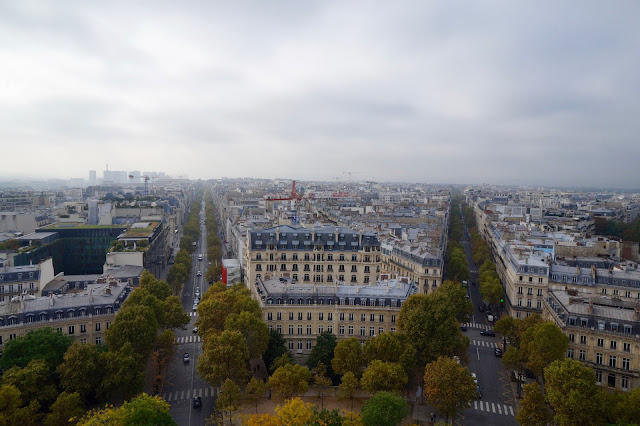The Triumphal Arch
The Arc de Triomphe, Arch de Triumph, or Triumphal Arch, however one refers to it, honors those who fought and died for France in the French Revolutionary War (Storm the Bastille) and the Napoleonic War. It has the names of all French victories and generals inscribed on its inner and outer surfaces. 

It was commissioned in 1806 after the victory at Austerlitz by Napoleon at the peak of his fortunes. Laying the foundations alone took two years and, in 1810, when Napoleon entered Paris from the west with his bride Archduchess Marie Louise of Austria, he had a wooden mock-up of the completed arch constructed
We got to see inside the Arch.
And then we went on top to view the city from the center of the
Place Charles de Gaulle, at the western end of the Champs-Elysees
Place Charles de Gaulle, at the western end of the Champs-Elysees

Sacra Couer is over the left shoulder of this person taking pictures. We will be going there soon!
Roger, pausing from his picture taking to figure out where I am on this Arch!
I'm sorry about so many shots of the Eiffel Tower, but I just couldn't choose!
We finally went back down to earth. These images are on the front of the arch
facing Concorde Square. there are six reliefs on the Arch depicting important
moments of the French Revolution.
Le Triomphe de 1810
Picturing Napoleon being decorated for his triumph.
Le Départ de 1792, The Marseillais volunteers departing
The Marseillaise was a revolutionary song, an anthem to freedom, a patriotic call to mobilize all the citizens and an exhortation to fight against tyranny and foreign invasion.
These images are above the images above!
Le Funerailles du Marceau, 20 September 1796
Marceau was a general in the Revolutionary Wars
La Bataille d'Aboukir, 25 July 1799
Aboukir was a battle in which Napoleon defeated the Ottoman army on 25 July 1799. Obviously this was an important battle, in that it became inscribed on this notorious site.
Beneath the arch is the Tomb of the Unknown Soldier from World War I.
We also visited the site where the Bastille once was located. The memorial to this turning point in French history now is a column, called Colonne de Juilliet. The memorial square straddles three districts they call arrondissements.
This memorial stands where the Bastille prison once stood until the "Storming of the Bastille, and its physical destruction between 14 July 1789 and 14 July 1790 during the French Revolution. Nothing of the prison remains today.
The Bastille was built between 1370 and 1383 during the reign of King Charles V as part of the defenses of Paris, the structure was converted into a state prison in the 17th century by Richelieu, who was king Louis XII's chief minister. At that time it primarily housed political prisoners, but also religious prisoners, writers of sedition, and young rakes held at the request of their families. It began to acquire a poor reputation when it became the main prison for those taken under lettres de cachet issued by the King of France. Lettres de cachet were letters signed by the king, countersigned by one of his ministers, and closed with the royal seal, or cachet. They contained orders directly from the king, often to enforce arbitrary actions and judgments that could not be appealed.
By the late 18th century, the building was made up of eight close-packed towers, surrounding two courtyards and the armoury. The governor of the prison was given a daily allowance per prisoner, the amount depending on their status. In terms of standards, there were many worse prisons in France. The Bastille was a place of horror and oppression, a symbol of autocratic cruelty.
The Storming the Bastille occurred on the afternoon of 14 July 1789. The prison contained just seven inmates at the time of its storming but was a symbol of abuses by the monarchy; its fall was the flashpoint of the French Revolution. Viva La France!!
Prise de la Bastille by jean-Pierre Houel
What a triumphal day! It is exciting to see people of another country displaying
their pride in their country. It is also an humbling experience.Information from Wikipedia.






























No comments:
Post a Comment